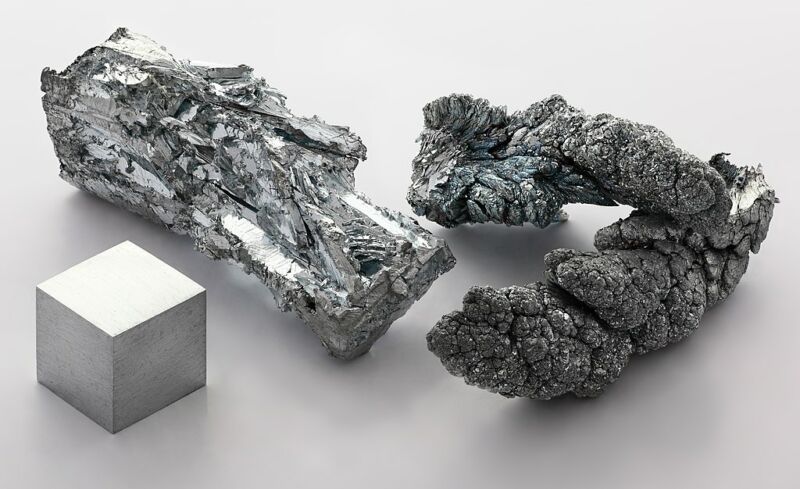
Most of the disposable batteries you'll come across are technically termed alkaline batteries. They work at high pH and typically use zinc as the charge carrier. Zinc is great because it's very cheap, can be used to make one of the two electrodes, and, in the right context, allows the use of air at the other electrode. These latter two items simplify the battery, allowing it to be more compact and lighter weight—so far, attempts to do similar things with lithium batteries have come up short.
The problem with all of this is that the batteries are disposable for a good reason: the chemistry of discharging doesn't really allow things to work in reverse. Carbon dioxide from the air reacts with the electrolyte, forming carbonates that block one electrode. And the zinc doesn't re-deposit neatly on the electrode it came from, instead creating spiky structures called dendrites that can short out the battery.
Now, an international team has figured out how to make zinc batteries rechargeable. The answer, it seems, involves getting rid of the alkaline electrolyte that gave the batteries their name.
A chemical one-way street
The chemistry of an alkaline zinc battery is pretty simple on the surface. Zinc metal foil serves as one electrode, with each zinc ion liberating two electrons. At the other electrode, oxygen molecules in the air pick up four of these electrons, breaking the molecule up and enabling the formation of zinc oxide. But the devil is in the details or, more specifically, the reaction intermediates. In this case a key intermediate is a hydroxide ion, formed naturally in the alkaline pH of the water-based electrolyte (in fact, pretty much defining that environment). It's involved in some of the reactions with zinc, which doesn't directly react with the oxygen in the air.
Those hydroxide ions are also the source of one of the problems with zinc-air batteries, as they're also an intermediate in the reactions that convert carbon dioxide into carbonates. These carbonates coat the electrode where oxygen reacts and eventually block it. This can be avoided to an extent by replacing the air with pure oxygen, but this only extends the lifetime to a dozen cycles or so.
Dealing with the hydroxide ions wouldn't necessarily address the formation of dendrites on the zinc metal sheet, it could handle the problems at the air electrode. So, the researchers focused on that.
This wasn't simply a matter of changing the pH of the electrolyte solution, as hydroxide ions form in water at neutral and even acidic pHs. And, under normal conditions, the breakdown of oxygen at the air electrode occurs via hydroxide intermediates. So, the researchers replaced the alkaline conditions with an electrolyte that is somewhat hydrophobic, or water-repelling. The chemical they used, trifluoromethanesulfonate, is essentially a sulfate ion linked to a carbon with three fluorides attached. The carbon-fluorine portion of the molecule repels water, while the sulfate portion is able to interact with zinc ions.
This changes everything
Switching to this new electrolyte does manage to shelter the zinc to a degree. But it has a larger impact on the reaction at the air electrode. Here, the normal reaction involves transferring four electrons to break down an O2 molecule via hydroxide intermediates. With the new electrolyte swapped in, hydroxide intermediates stop forming. As a result, only two electrons are transferred to the oxygen molecule, creating a peroxide. As a result, ZnO2 forms when the battery discharges, instead of zinc oxide (ZnO).
The researchers detected the formation of zinc peroxide fibers when discharged, and confirmed these disappeared during a recharge. They could also detect pressure changes associated with the oxygen being incorporated into the battery during discharge, and liberated when the battery was recharged. When zinc foil was used as an electrode, over 80 percent of the zinc ended up being used for the discharge. Replacing that with a zinc powder boosted the zinc utilization to 94 percent.
The results were radically different. Rather than dying after a couple of cycles, the researchers managed to cycle one battery for 1,600 hours. Dendrite formation wasn't a problem for most of the time, and the capacity per weight was somewhere in the neighborhood of double that of some lithium batteries.
So, battery problems solved? Not really. Because the battery chemistry relies on air, the water in the aqueous electrolyte evaporated over time. Dendrites did form, eventually rendering the zinc metal anode unusable. But the biggest problem is probably the rate of charge—note that a charge/discharge cycle took 20 hours
Boost the current density by a factor of 10, and the battery only ran for 160 hours. Boost the charge density even more, and you start breaking down water instead of operating a battery.
The research team suggests that a catalyst that promotes peroxide formation could potentially boost the charge/discharge rate, but it's clear that this isn't necessarily a competitor for many lithium battery use cases.
But that may not be a problem. Storage for the electric grid doesn't necessarily need a fast rate of discharge from individual batteries, as long as enough batteries are available to match capacity needs. And here, zinc might be a bonus—it costs less than a quarter what lithium carbonate does, and that's for pure zinc. Plus, having zinc available to cover other needs would free up lithium for uses where its performance characteristics really matter—something we may need if we try to make the grid renewable at the same time we electrify transportation.
Finally, the researchers note that the same sort of chemistry could work with other metals, including magnesium and aluminum, both of which are also relatively inexpensive. It may be that these alternatives have a different balance between advantages and drawbacks, and they certainly wouldn't compete for the lithium supply, either.
Science, 2020. DOI: 10.1126/science.abb9554 (About DOIs).
reader comments
200